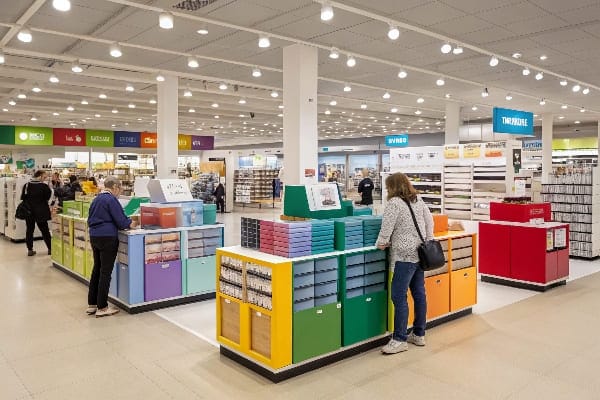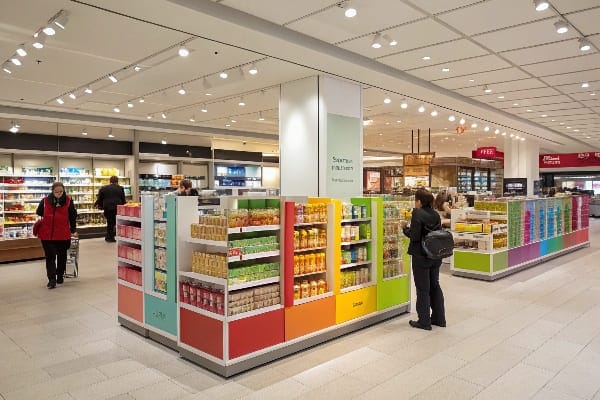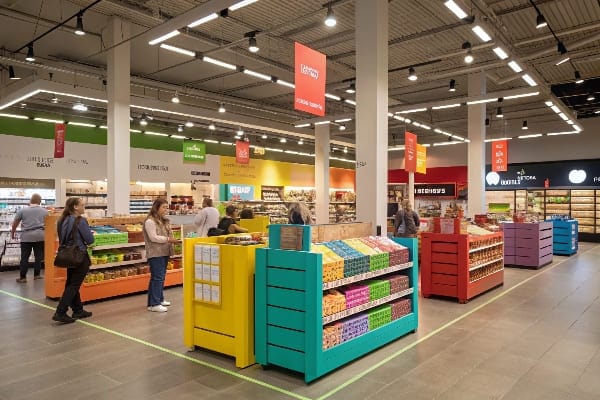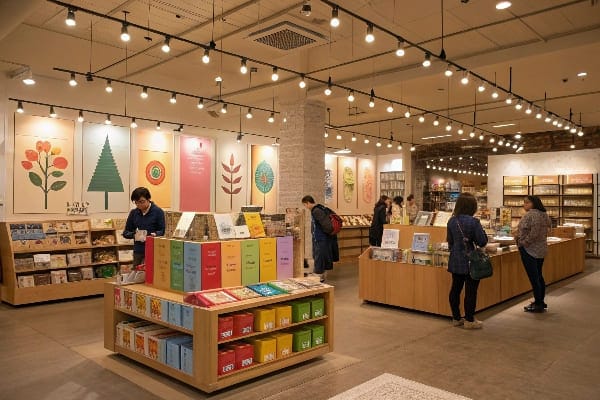零售商店设计是企业策略的重要方面。它不仅仅是美学;它是塑造客户体验,优化产品放置并鼓励购买行为的强大工具。了解设计如何影响整体客户旅程对于任何希望使其商店更具吸引力和盈利的零售商至关重要。
零售商店设计是指零售环境的战略规划,包括布局,显示和视觉元素。它旨在增强客户体验,影响购买决策并提高商店功能。

创建成功的零售空间不仅涉及选择有吸引力的家具或配色方案。它需要深入了解目标受众,您出售的产品以及您想要创造的氛围。在本文中,我们将探讨零售商如何选择其商店设计,零售设计的概念,四种主要类型的商店布局以及影响商店设计的高度注意事项。
零售商如何选择其商店设计?
选择商店设计并不像挑选时尚装饰或遵循最新趋势那样简单。它涉及仔细计划和考虑几个因素,包括所出售产品类型,目标市场和整体品牌标识。
零售商通常会根据其目标受众,产品和品牌价值选择商店设计。位置,流量和预算等因素在决策过程中也起着至关重要的作用。

设计商店需要平衡功能与创造力。零售商通常从分析其客户群1。例如,高端时装商店可能会专注于优雅和简约的设计,以与其品牌保持一致,而技术商店可能会优先显示显示最新小工具的展示。布局是另一个重要的考虑因素。零售商必须确定客户将如何流过商店,放置高需求物品以及如何创建鼓励探索的诱人空间。
商店设计2的选择受建筑物建筑的影响。零售商可以在现有结构的范围内工作,而其他零售商可能有机会完全自定义其布局。预算限制始终是一个因素,因为创建有吸引力且功能性的零售环境3可能很昂贵。
零售设计的概念是什么?
零售设计不仅仅是美学选择。这是一种精心计划的策略,旨在增强购物体验。零售设计背后的概念围绕创造一个吸引和保留客户的环境,同时也最大程度地提高商店的运营效率。
零售设计的概念集中在创建一个引人入胜的空间上,该空间鼓励客户购物更长,更有效。它涉及设计元素(例如照明,颜色,标牌和布局)的战略组合,以优化购物体验。

有效的零售设计4旨在传达品牌的身份和价值观。无论是通过大胆标牌,巧妙的产品显示还是商品的布置,商店内的所有内容都应共同加强整体品牌信息5 。例如,一家豪华商店可能会使用高端材料,例如大理石地板和金固定装置,而快时的商店可能会选择更充满活力的现代设计。
通过商店的旅程6方面也起着至关重要的作用周到的标牌,显示和照明可以将注意力转移到特定的产品或部分上。重要的是,设计不仅看起来很吸引人,而且可以有效地发挥作用,从而带来更高的销售额和更高的客户满意度。
零售商店布局的四种主要类型是什么?
零售商店的布局是总体设计策略的重要组成部分。正确的布局可以显着改善客户流量和销售。零售商店布局有四种主要类型,每个零售商店的布局旨在实现特定目标。
零售商店布局的四种主要类型是:网格,环,自由形式和脊柱。每个布局旨在优化客户的流量和产品的放置。

网格布局
网格布局7是最常见的商店设计类型之一。它通常用于超市,药店和其他零售环境中,这些零售环境的重点是为客户提供各种产品。该布局使用了长长的过道和货架,为客户提供了清晰可预测的途径。网格布局的主要优点是它在最大化产品放置方面的效率和使客户轻松找到所需的东西。
循环布局
循环布局8旨在鼓励客户探索整个商店。该布局通常具有圆形或矩形路径,可指导客户通过商店。它通常用于百货商店和大型零售空间,目标是使客户接触到尽可能多的产品。循环布局可有效促进冲动购买,因为客户可能会在旅途中遇到各种产品类别。
自由形式的布局
自由形式的布局9更加轻松和创造力。这种布局通常用于高端零售商店,精品店和时尚零售商。它允许在产品放置方面具有更大的灵活性,并创造更开放的诱人空间。自由形式的布局通常包含创意展示和特色领域,以吸引客户并鼓励他们流连忘返。这种布局非常适合创造豪华或独特的购物体验。
脊柱布局
脊柱布局是网格和循环布局的混合体。它涉及在商店中运行的中央过道或“脊柱”,两侧的产品显示。这种布局通常用于较大的商店或陈列室,目标是为客户创造清晰简便的道路,同时仍鼓励他们探索商店的各个部分。脊柱布局在大型商店和家具商店中很受欢迎。
一家零售店的高度是多少?
零售商店的高度在其整体设计中起着至关重要的作用。它影响了商店的气氛,标牌和显示器的放置以及客户如何看待空间。天花板高度可能会明显差异,具体取决于商店的位置,建筑类型和设计目标。
零售商店的高度是指地板和天花板之间的距离,它可能会影响空间的感觉。较高的天花板往往会产生开放感和奢华感,而较低的天花板会使空间变得更加亲密和舒适。

高高的天花板通常用于想要创造出宏伟而开放的感觉的商店,例如奢侈品零售商,家具店或美术馆。这种类型的设计可以使空间更加膨胀,并有助于突出高端商品。另一方面,天花板较低的商店可能专注于创建更个性化和亲密的购物体验10 ,例如精品服装店或专业商店。
商店的高度还会影响商品显示的方式。例如,高天花板11可能使用高架子单元或悬挂显示器向上引起注意。同时,低天花板的商店可能会使用更多紧凑的展示来维持舒适,热情的气氛。
结论
零售商店设计是创造成功的零售环境的关键方面。从选择正确的布局到考虑商店的高度,每个元素都在增强客户体验和增强销售方面发挥作用。
了解您的客户群对于定制与购物者共鸣并推动销售共鸣的零售策略至关重要。 ↩
探索商店设计中的最佳实践可以帮助零售商创造更具吸引力和功能性的购物体验。 ↩
发现成功的零售环境的关键要素可以提高客户满意度并提高销售额。 ↩
探索零售设计中的最佳实践可以帮助您了解如何有效地传达品牌的身份并增强客户体验。 ↩
了解加强品牌信息的策略可以帮助您创建凝聚力和有影响力的零售环境。 ↩
了解零售设计如何影响客户的旅程可以为创造更具吸引力的购物体验提供见解。 ↩
探索网格布局在零售中的好处,以了解它们如何增强客户体验和产品可见性。 ↩
发现循环布局如何推动冲动购买并改善零售空间中的客户参与度。 ↩
了解自由形式布局的独特功能,这些布局创造了诱人的购物环境并增强客户体验。 ↩
此链接将帮助您了解商店设计对客户体验和参与度的心理影响。 ↩
探索此资源将提供有关高高天花板如何增强购物体验和商品展示的见解。 ↩

